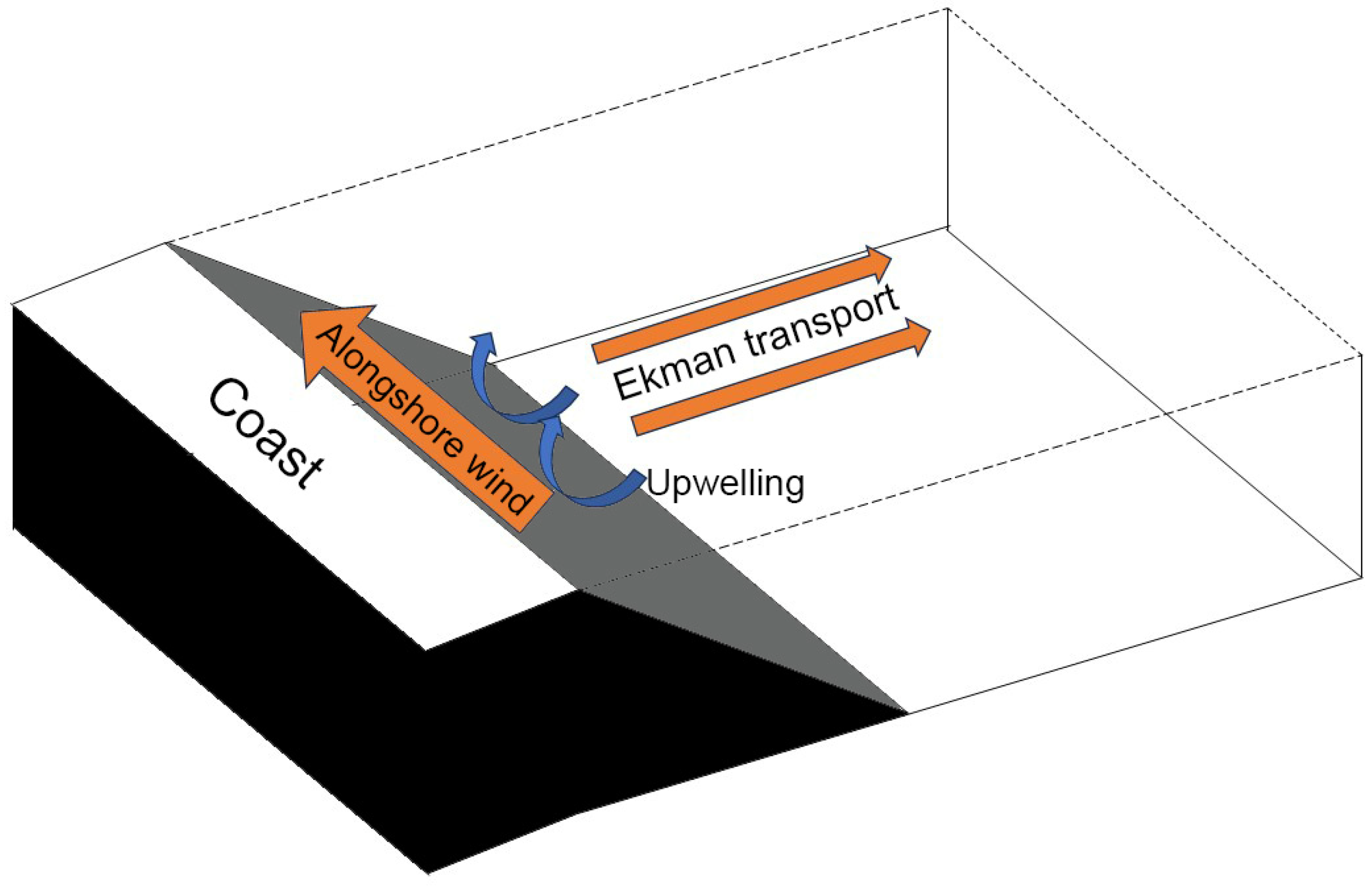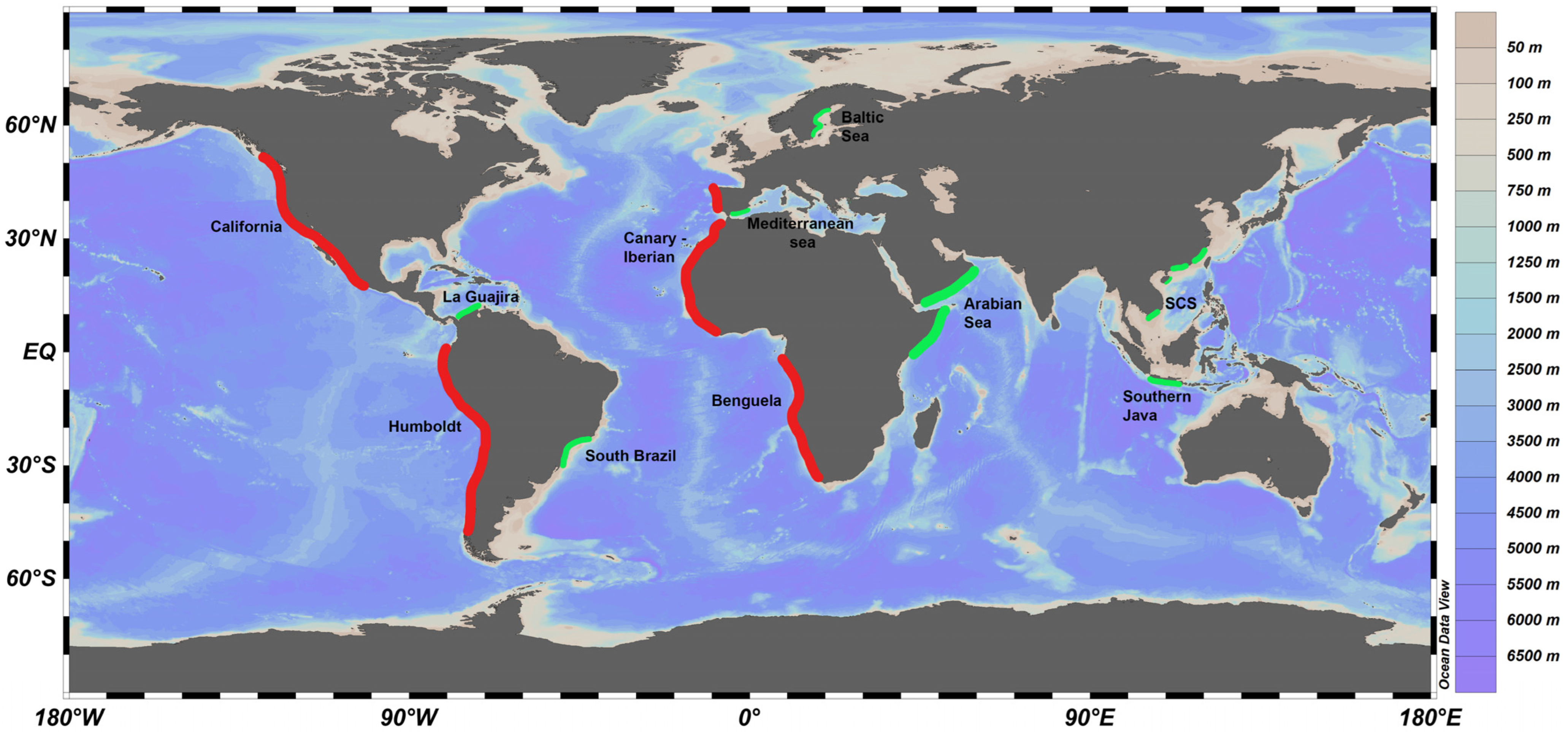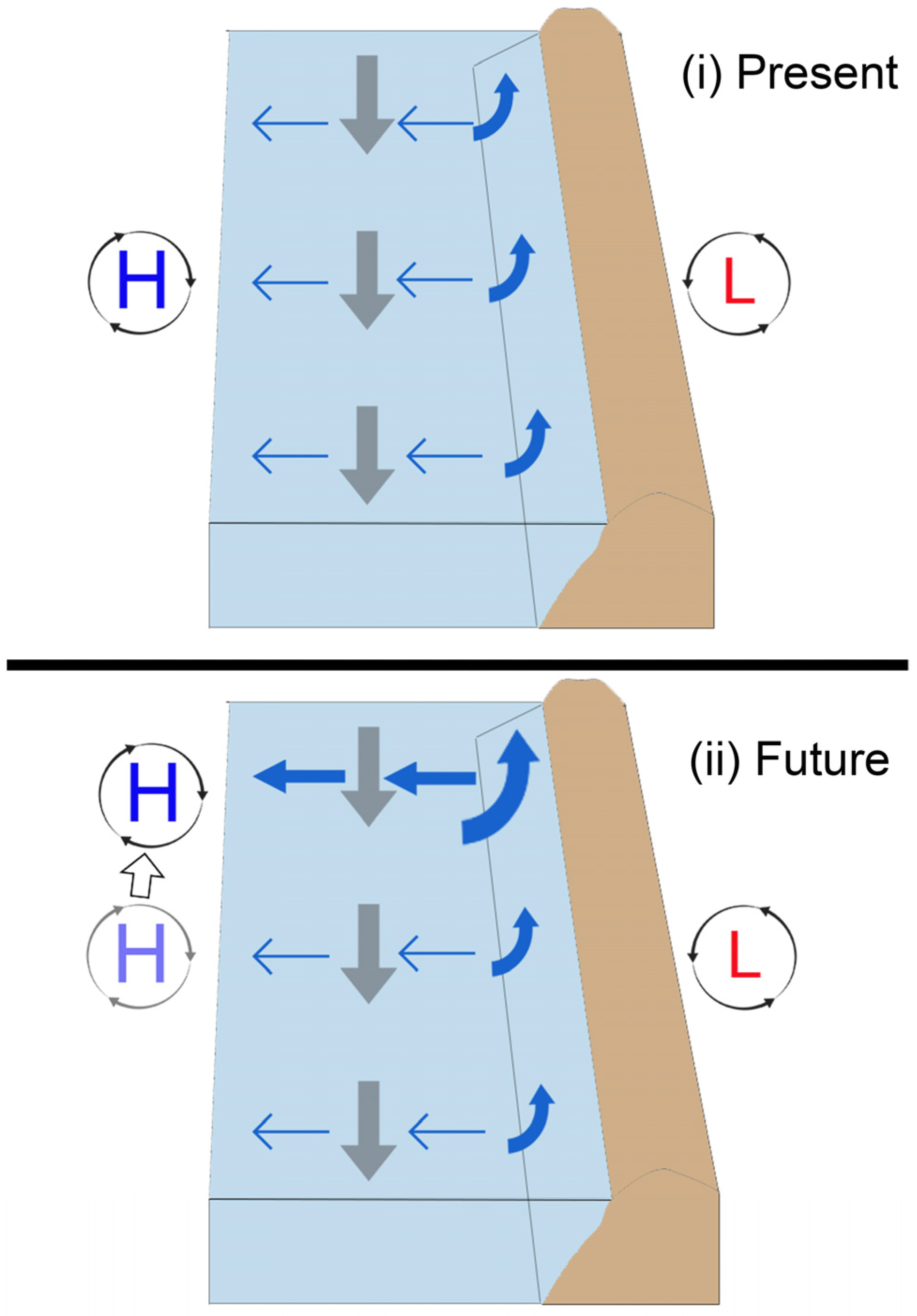
| Version | Summary | Created by | Modification | Content Size | Created at | Operation |
|---|---|---|---|---|---|---|
| 1 | Muhammad Naim Satar | -- | 1395 | 2023-08-03 10:30:03 | | | |
| 2 | Catherine Yang | Meta information modification | 1395 | 2023-08-04 03:12:30 | | |
Video Upload Options
Upwelling refers to the upward movement of deep nutrient-rich and low-temperature waters to the surface, resulting in colder surface or near-surface waters with low dissolved oxygen, high density, and high salinity. Upwelling is economically and ecologically significant in the coastal marine system, making it high-priority research. Although representing <1% of the total surface area of the ocean, upwelling regions provide approximately 8% of the global marine primary production and more than 20% of the world’s capture fisheries. With an increase in offshore transport, strong upwelling usually transports phytoplankton and zooplankton towards the convergence offshore frontal system rapidly, relative to a weaker upwelling that limits the nutrient enrichment in the photic zone. Apart from boosting primary productivity and fishery production, upwelling is also crucial for the atmosphere-ocean carbon dioxide exchange and carbon recycling processes.
1. Characteristics of Wind-Driven Upwelling


| Marginal Sea | Location of Upwelling | Time Occurring | Author |
|---|---|---|---|
| South China Sea | Taiwan Strait | Southwest Monsoon (June to August) |
[19][20] |
| Southern Vietnam | Southwest Monsoon (June to August) |
[14][15] | |
| Hainan Island | Southwest Monsoon (June to August) |
[21][22] | |
| East Coast of Peninsular Malaysia | Southwest Monsoon (June to August) |
[11][12][13] | |
| Northwest Luzon | Northeast Monsoon (December to March) |
[5][6][7] | |
| Northwest Sabah | Northeast Monsoon (December to March) |
[8][9][10] | |
| Andaman Sea | Andaman Sea | Northeast Monsoon (December to March) |
[23] |
| Arabian Sea | Somali and Oman | Southwest Monsoon (June to September) | [24][25][26][27] |
| Southwest India | Southwest Monsoon (May to September) | [28][29] | |
| Indian Ocean | Southern Java | Southeast Monsoon (June to October) | [30][31][32] |
| Baltic Sea | Gulf of Finland | Summer (June to September) |
[17][33] |
2. Upwelling and Climate/Atmosphere Variability
3. Climate Change versus Upwelling


References
- Rossi, V.; Morel, Y.; Garçon, V. Effect of the wind on the shelf dynamics: Formation of a secondary upwelling along the continental margin. Ocean. Model. 2010, 31, 51–79.
- Pickett, M.H.; Paduan, J.D. Ekman transport and pumping in the California Current based on the U.S. Navy’s high-resolution atmospheric model (COAMPS). J. Geophys. Res. Ocean. 2003, 108, 3327.
- Kämpf, J.; Chapman, P. The Functioning of Coastal Upwelling Systems. In Upwelling Systems of the World; Springer International Publishing: Cham, Switzerland, 2016; pp. 31–62.
- Sylla, A.; Mignot, J.; Capet, X.; Gaye, A.T. Weakening of the Senegalo–Mauritanian upwelling system under climate change. Clim. Dyn. 2019, 53, 4447–4473.
- Shaw, P.T.; Chao, S.Y.; Liu, K.K.; Pai, S.C.; Liu, C.T. Winter upwelling off Luzon in the northeastern South China Sea. J. Geophys. Res. 1996, 101, 16435–16448.
- Udarbe-Walker, M.J.B.; Villanoy, C.L. Structure of potential upwelling areas in the Philippines. Deep. Res. Part I Oceanogr. Res. Pap. 2001, 48, 1499–1518.
- Wang, J.J.; Tang, D.L.; Sui, Y. Winter phytoplankton bloom induced by subsurface upwelling and mixed layer entrainment southwest of Luzon Strait. J. Mar. Syst. 2010, 83, 141–149.
- Abdul-Hadi, A.; Mansor, S.; Pradhan, B.; Tan, C.K. Seasonal variability of chlorophyll-a and oceanographic conditions in Sabah waters in relation to Asian monsoon—A remote sensing study. Environ. Monit. Assess. 2013, 185, 3977–3991.
- Yan, Y.; Ling, Z.; Chen, C. Winter coastal upwelling off northwest Borneo in the South China Sea. Acta Oceanol. Sin. 2015, 34, 3–10.
- Satar, M.N.; Akhir, M.F.; Kok, P.H.; Daud, N.R. Upwelling in the northwest Sabah during the northeast monsoon and its relaion with El-Niño. Res. Mar. Sci. 2020, 5, 681–698.
- Akhir, M.F.; Daryabor, F.; Husain, M.L.; Tangang, F.; Qiao, F. Evidence of Upwelling along Peninsular Malaysia during Southwest Monsoon. Open. J. Mar. Sci. 2015, 5, 273–279.
- Kok, P.H.; Akhir, M.F.M.; Tangang, F.; Husain, M.L. Spatiotemporal trends in the southwest monsoon wind-driven upwelling in the southwestern part of the South China Sea. PLoS ONE 2017, 12, e0171979.
- Kok, P.H.; Wijeratne, S.; Akhir, M.F.; Pattiaratchi, C.; Chung, J.X.; Roseli, N.H.; Daud, N.R. Modeling approaches in the investigation of upwelling along the east coast of Peninsular Malaysia: Its driven mechanisms. Reg. Stud. Mar. Sci. 2022, 55, 102562.
- Kuo, N.J.; Zheng, Q.; Ho, C.R. Response of Vietnam coastal upwelling to the 1997–1998 ENSO event observed by multisensor data. Remote Sens. Environ. 2004, 89, 106–115.
- Dippner, J.W.; Nguyen, K.V.; Hein, H.; Ohde, T.; Loick, N. Monsoon-induced upwelling off the Vietnamese coast. Ocean. Dyn. 2007, 57, 46–62.
- Wyrtki, K. Scientific results of marine investigations of the South China Sea and the Gulf of Thailand 1959–1961. Naga Rep. 1961, 2, 164–169.
- Suursaar, Ü. Winter upwelling in the Gulf of Finland, Baltic Sea. Oceanologia 2021, 63, 356–369.
- Umasangaji, H.; Ramili, Y. Mini review: Characteristics of upwelling in several coastal areas in the world. IOP Conf. Ser. Earth Environ. Sci. 2021, 890, 012004.
- Tang, D.L.; Kester, D.R.; Ni, I.H.; Kawamura, H.; Hong, H. Upwelling in the Taiwan Strait during the summer monsoon detected by satellite and shipboard measurements. Remote Sens. Environ. 2002, 83, 457–471.
- Hong, H.; Zhang, C.; Shang, S.; Huang, B.; Li, Y.; Li, X.; Zhang, S. Interannual variability of summer coastal upwelling in the Taiwan Strait. Cont. Shelf Res. 2009, 29, 479–484.
- Lü, X.; Qiao, F.; Wang, G.; Xia, C.; Yuan, Y. Upwelling off the west coast of Hainan Island in summer: Its detection and mechanisms. Geophys. Res. Lett. 2008, 35, L02604.
- Su, J.; Pohlmann, T. Wind and topography influence on an upwelling system at the eastern Hainan coast. J. Geophys. Res. Ocean. 2009, 114, C06017.
- Buranapratheprat, A.; Laongmanee, P.; Sukramongkol, N.; Ritthirong, P.; Promjinda, S.; Yanagi, T. Upwelling induced by meso-scale cyclonic eddies in the Andaman Sea. Coast. Mar. Sci. 2010, 34, 68–73.
- Shi, W.; Morrison, J.M.; Böhm, E.; Manghnani, V. The Oman upwelling zone during 1993, 1994 and 1995. Deep. Res. Part II Top. Stud. Oceanogr. 2000, 47, 1227–1247.
- Izumo, T.; Montegut, C.B.; Luo, J.J.; Behera, S.K.; Masson, S.; Yamagata, T. The role of the Western Arabian Sea upwelling in Indian monsoon rainfall variability. J. Clim. 2008, 21, 5603–5623.
- Cabarcos, E.; Flores, J.A.; Singh, A.D.; Sierro, F.J. Monsoonal dynamics and evolution of the primary productivity in the eastern Arabian Sea over the past 30 ka. Palaeogeogr. Palaeoclimatol. Palaeoecol. 2014, 411, 249–256.
- Capet, X.; Roullet, G.; Carton, X. Western boundary upwelling dynamics off Oman. Ocean. Dynamics. 2017, 67, 585–595.
- Smitha, B.R.; Sanjeevan, V.N.; Vimalkumar, K.G.; Revichandran, C. On the Upwelling off the Southern Tip and along the West Coast of India. J. Coast. Res. 2008, 24, 95–102.
- Shah, P.; Sajeev, R.; Thara, K.J.; George, G.; Shafeeque, M.; Akash, S.; Platt, T. A Holistic Approach to Upwelling and Downwelling along the South-West Coast of India. Mar. Geod. 2019, 42, 64–84.
- Susanto, R.D.; Gordon, L.; Zheng, Q. Upwelling along the coasts of Java and Sumatra and its relation to ENSO. Geophys. Res. Lett. 2001, 28, 1599–1602.
- Horii, T.; Ueki, I.; Syamsudin, F.; Sofian, I.; Ando, K. Intraseasonal coastal upwelling signal along the southern coast of Java observed using Indonesian tidal station data. J. Geophys. Res. Ocean. 2016, 121, 2690–2708.
- Horii, T.; Ueki, I.; Ando, K. Coastal upwelling events along the southern coast of Java during the 2008 positive Indian Ocean Dipole. J. Oceanogr. 2018, 74, 499–508.
- Uiboupin, R.; Laanemets, J. Upwelling characteristics derived from satellite sea surface temperature data in the Gulf of Finland, Baltic sea. Boreal. Environ. Res. 2009, 14, 297–304.
- Macias, D.; Landry, M.R.; Gershunov, A.; Miller, A.J.; Franks, P.J.S. Climatic control of upwelling variability along the Western North-American coast. PLoS ONE 2012, 7, e30436.
- Li, X.; Ting, M. Recent and future changes in the Asian monsoon-ENSO relationship: Natural or forced? Geophys. Res. Lett. 2015, 42, 3502–3512.
- Barber, R.T.; Chavez, F.P. Biological consequences of El Niño. Science 1983, 222, 1203–1210.
- Jacox, M.G.; Fiechter, J.; Moore, A.M.; Edwards, C.A. ENSO and the California Current coastal upwelling response. J. Geophys. Res. Ocean. 2015, 120, 1691–1702.
- Jing, Z.; Qi, Y.; Du, Y. Upwelling in the continental shelf of northern South China Sea associated with 1997–1998 El Niño. J. Geophys. Res. Ocean. 2011, 116, C0203.
- Zhang, W.; Wang, Y.; Jin, F.F.; Stuecker, M.F.; Turner, A.G. Impact of different El Niño types on the El Niño/IOD relationship. Geophys. Res. Lett. 2015, 42, 8570–8576.
- Bakun, A. Global Climate Change and Intensification of Coastal Ocean Upwelling. Science 1990, 247, 198–201.
- Wang, D.; Gouhier, T.C.; Menge, B.A.; Ganguly, A.R. Intensification and spatial homogenization of coastal upwelling under climate change. Nature 2015, 518, 390–394.
- Rykaczewski, R.R.; Dunne, J.P.; Sydeman, W.J.; García-Reyes, M.; Black, B.A.; Bograd, S.J. Poleward displacement of coastal upwelling-favorable winds in the ocean’s eastern boundary currents through the 21st century. Geophys. Res. Lett. 2015, 42, 6424–6431.
- Maranón, E.; Fernández, E. Changes in phytoplankton ecophysiology across a coastal upwelling front. J. Plankton Res. 1995, 17, 1999–2008.
- Chhak, K.; Di Lorenzo, E. Decadal variations in the California Current upwelling cells. Geophys. Res. Lett. 2007, 34, L14604.




